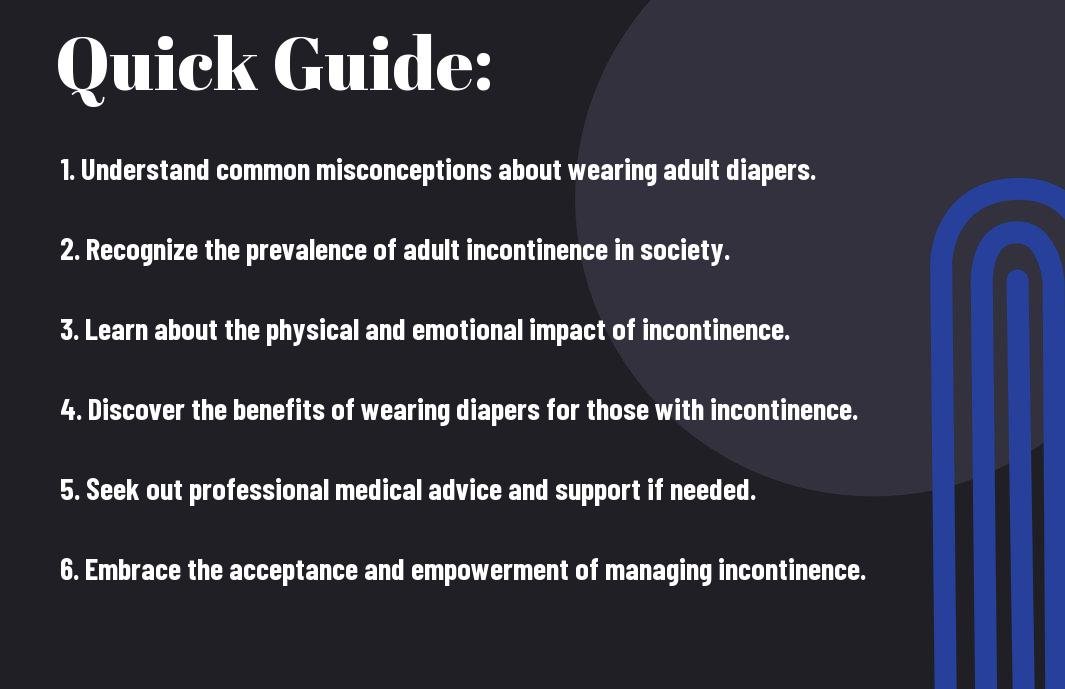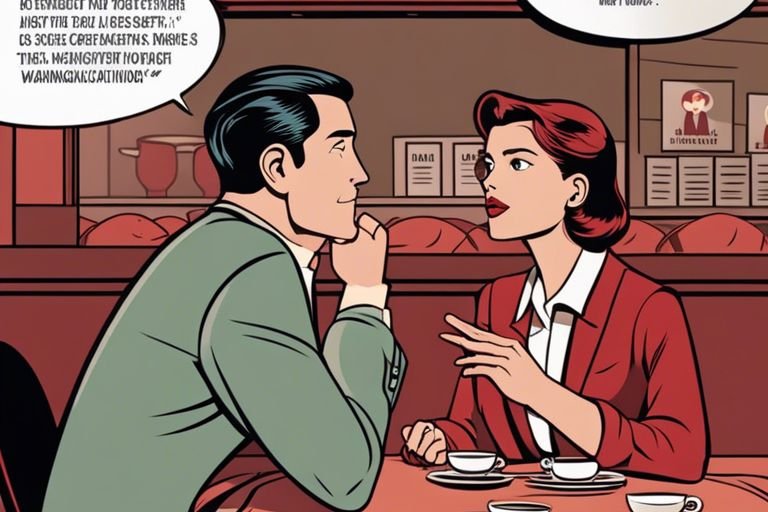Perusing through the complex world of adult incontinence, diapers and associated products may seem like a jarring and uncomfortable topic. However, the truth is that many adults suffer from incontinence, and wearing protective garments such as diapers can actually be a crucial and positive solution. In this comprehensive guide, I will delve into the dangerous health effects of ignoring incontinence, the positive impact of wearing diapers, and the surprising truth about adult incontinence that you need to know. Whether you are personally dealing with incontinence or caring for someone who is, this is a topic that deserves your attention.
Key Takeaways:
- Adult incontinence is a common condition that affects millions of people worldwide, and wearing diapers can provide the necessary support and comfort for those dealing with it.
- Wearing diapers as a solution for incontinence can significantly improve the quality of life for individuals, allowing them to continue their daily activities with confidence and dignity.
- Contrary to popular belief, wearing adult diapers is not inherently “bad” and should not be stigmatized. It is a practical solution to a medical condition and should be normalized in society.
- Seeking professional medical advice and exploring different diaper options is crucial for managing adult incontinence effectively and finding the right fit for individual needs.
- Providing support and understanding for individuals with adult incontinence is essential to combatting the stigma and fostering a more inclusive and compassionate community.
Types of Adult Incontinence
The two main types of adult incontinence are stress incontinence and urge incontinence. Other less common types include overflow incontinence, functional incontinence, and mixed incontinence.
| Stress Incontinence | Urge Incontinence |
| Characterized by leakage of urine during activities such as coughing, sneezing, or exercising. | Characterized by a sudden, intense urge to urinate followed by an involuntary loss of urine. |
| Often caused by weakened pelvic floor muscles due to childbirth, surgery, or aging. | Caused by overactivity of the bladder muscles or damage to the nerves that control the bladder. |
| Common in women, but can also affect men. | More common in older adults and often associated with conditions such as diabetes or Parkinson’s disease. |
| Treatment options include pelvic floor exercises, lifestyle changes, and in some cases, surgery. | Treatment may include medication, behavioral strategies, and bladder training. |
| Stress incontinence may cause embarrassment and affect quality of life, but it is not usually a sign of a serious underlying condition. | Urge incontinence can be a sign of a more serious underlying health issue and may require medical intervention. |
Stress Incontinence
Stress incontinence is characterized by the leakage of urine during activities such as coughing, sneezing, or exercising. It is often caused by weakened pelvic floor muscles due to childbirth, surgery, or aging. This type of incontinence is common in women, but it can also affect men. Treatment options include pelvic floor exercises, lifestyle changes, and in some cases, surgery. While stress incontinence may cause embarrassment and affect quality of life, it is not usually a sign of a serious underlying condition.
Urge Incontinence
Urge incontinence is characterized by a sudden, intense urge to urinate followed by an involuntary loss of urine. It is caused by overactivity of the bladder muscles or damage to the nerves that control the bladder. This type of incontinence is more common in older adults and is often associated with conditions such as diabetes or Parkinson’s disease. Treatment may include medication, behavioral strategies, and bladder training. Urge incontinence can be a sign of a more serious underlying health issue and may require medical intervention.
Tips for Managing Adult Incontinence
Obviously, dealing with adult incontinence can be challenging, but there are several strategies that can help you effectively manage this condition. Here are some important tips to help you navigate the daily challenges of living with incontinence:
- Stay well-hydrated, but avoid consuming large amounts of caffeine and alcohol.
- Always carry extra incontinence products with you when you leave home.
- Keep a bladder diary to track your symptoms and identify any triggers.
- Practice Kegel exercises to strengthen your pelvic floor muscles.
After implementing these strategies, you will likely find that managing adult incontinence becomes more manageable and less disruptive to your daily life.
Lifestyle Changes
For many individuals with adult incontinence, making small lifestyle changes can greatly impact the frequency and severity of their symptoms. These changes may include modifying your diet, scheduling regular bathroom breaks, and incorporating regular exercise into your routine. By taking control of these lifestyle factors, you can effectively manage your incontinence and improve your overall quality of life.
Proper Hygiene
When dealing with adult incontinence, maintaining proper hygiene is crucial in preventing skin irritation and urinary tract infections. It is important to change your incontinence products frequently, cleanse the skin gently, and use protective barriers such as barriers creams to prevent skin breakdown. By prioritizing proper hygiene, you can minimize the risk of complications and maintain your comfort and dignity.
Choosing the Right Products
When it comes to managing adult incontinence, choosing the right products is essential for effectively managing your symptoms. Whether you opt for disposable or reusable products, selecting those that provide maximum absorption and a comfortable fit is crucial. Additionally, utilizing products with odor-control features can help you feel more confident and secure throughout the day. Don’t be afraid to experiment with different products to find the best fit for your needs.
Step-by-Step Guide to Dealing with Adult Incontinence
Your journey to dealing with adult incontinence can be overwhelming, but it is crucial to take it one step at a time and seek the appropriate help and support. Here is a guide to help you navigate through this challenging condition.
| Recognizing Symptoms | Seeking Medical Help |
|---|---|
|
Recognizing the symptoms of adult incontinence is the first step towards finding relief. This can include urinary leakage, an urgent need to urinate, or the inability to control bowel movements. Keep track of your symptoms to share with your healthcare provider. |
If you have been experiencing symptoms of adult incontinence, it is essential to seek medical help. Schedule an appointment with a healthcare provider who can perform a thorough evaluation and provide the necessary support and guidance. |
Developing a Treatment Plan
Once you have recognized the symptoms and sought medical help, the next step is to develop a treatment plan. This may involve lifestyle changes, pelvic floor exercises, medication, or surgical interventions. Your healthcare provider will work with you to create a personalized plan that can effectively manage your symptoms and improve your quality of life.
Factors Affecting Adult Incontinence
After researching extensively, I have found that there are several factors that can affect adult incontinence. It’s important to understand these factors in order to effectively manage and treat this condition. Here are some of the main factors that can contribute to adult incontinence:
- Age and Gender: Age and gender play a significant role in the development of adult incontinence. As we age, our bladder muscles tend to weaken, leading to a higher risk of incontinence. Additionally, women are more prone to incontinence due to childbirth and hormonal changes.
- Medical Conditions: Certain medical conditions such as diabetes, multiple sclerosis, and Parkinson’s disease can affect bladder control and lead to incontinence.
- Medications: Some medications, such as diuretics, sedatives, and muscle relaxants, can cause urinary incontinence as a side effect. It’s important to discuss any concerns with your healthcare provider if you suspect your medications may be contributing to your incontinence.
Knowing these factors can help you better understand the underlying causes of adult incontinence and make informed decisions about treatment and management.
Age and Gender
Age and gender are significant factors in the development of adult incontinence. As I’ve mentioned earlier, as we age, our bladder muscles tend to weaken, leading to a higher risk of incontinence. Additionally, women are more prone to incontinence due to childbirth and hormonal changes.
Medical Conditions
Certain medical conditions such as diabetes, multiple sclerosis, and Parkinson’s disease can affect bladder control and lead to incontinence. It’s crucial to address these underlying medical issues in order to effectively manage adult incontinence.
Medications
Some medications, such as diuretics, sedatives, and muscle relaxants, can cause urinary incontinence as a side effect. It’s crucial to be aware of the potential side effects of your medications and discuss any concerns with your healthcare provider if you suspect your medications may be contributing to your incontinence.
Pros and Cons of Using Diapers for Adult Incontinence
Unlike the common misconception, wearing diapers for adult incontinence has both positive and negative aspects. Let’s take a closer look at the pros and cons of using diapers for managing adult incontinence.
| Pros | Cons |
| Provides protection and peace of mind | Potential discomfort and rash |
| Promotes independence and confidence | Can be expensive in the long run |
| Helps maintain dignity and self-esteem | Environmental impact |
| Convenient for managing on-the-go | Potential for skin irritation |
| Reduces the risk of embarrassing accidents | Adjustment period for finding the right fit |
Convenience and Comfort
When it comes to using diapers for adult incontinence, the convenience of being able to manage your condition on-the-go is a significant advantage. Additionally, modern adult diapers are designed to offer a comfortable fit and protection, allowing you to go about your daily activities without worrying about leaks or accidents. However, some individuals may experience discomfort and skin irritation due to prolonged use of diapers, which is an important factor to consider.
Environmental Impact and Cost
While using diapers can provide relief and convenience for managing adult incontinence, it’s important to acknowledge the environmental impact and cost associated with their use. Disposing of soiled diapers contributes to environmental waste, and the ongoing cost of purchasing diapers can add up over time. Additionally, there is a potential for skin irritation and rash, which may require additional medical attention and expenses.

Is It Bad to Wear Diapers? The Shocking Truth About Adult Incontinence
Considering all points, it is important to recognize that wearing diapers for adult incontinence is not inherently bad. In fact, it can greatly improve the quality of life for individuals dealing with incontinence issues. It allows for greater independence and confidence, enabling individuals to continue living their lives to the fullest. However, it is crucial to address the underlying causes of incontinence and seek proper medical treatment in conjunction with using diapers. By taking a proactive approach and seeking medical help, individuals can improve their overall health and potentially reduce or eliminate the need for diapers in the long run. Ultimately, the decision to wear diapers should be viewed as a practical and important solution for managing adult incontinence, rather than something to be ashamed of.
FAQ
Q: Is wearing diapers bad for adults with incontinence?
A: No, wearing diapers is not bad for adults with incontinence. In fact, it can improve their quality of life by providing comfort, dignity, and security.
Q: What are the potential health risks of not wearing diapers for adults with incontinence?
A: Not wearing diapers for adults with incontinence can lead to skin irritation, infections, and emotional distress. It can also limit their ability to engage in social activities and lead a normal life.
Q: Are there different types of diapers for adults with incontinence?
A: Yes, there are different types of diapers for adults with incontinence, including briefs, pull-ups, and pads. These products come in various absorbency levels to meet individual needs.
Q: How can adults with incontinence manage their condition effectively with diapers?
A: Adults with incontinence can manage their condition effectively with diapers by choosing the right fit and absorbency level, changing diapers regularly, practicing good hygiene, and seeking professional help if needed.
Q: What are some common misconceptions about adults wearing diapers for incontinence?
A: Some common misconceptions about adults wearing diapers for incontinence include the belief that it is embarrassing or shameful. In reality, it is a common and practical solution for managing incontinence and should be destigmatized.




